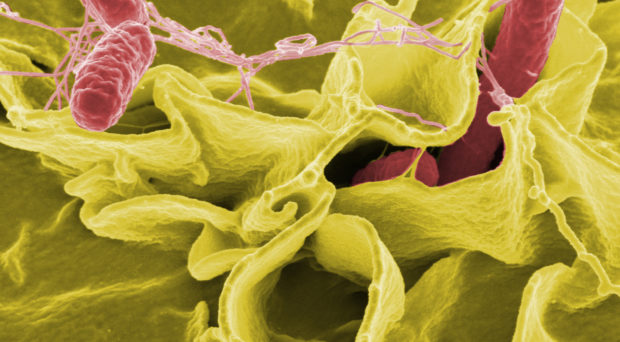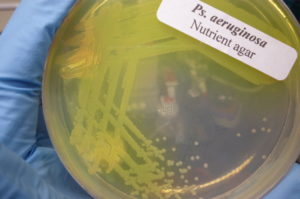
As if climate change, international terrorism, rising mental ill-health, teenage knife crime, post-Brexit instability and potential superpower tensions were not enough to worry the heck out of us parents, the real spectre of a post-antibiotic era looms. Will my children live as long as I? Will I live as long as my parents or die a lingering death from an untreatable infection picked up in a nursing home which functioned as a reservoir of antibiotic resistance? In 2013 England’s Chief Medical Officer considered the rise in antimicrobial resistance “a national civil emergency”(1). In May 2016, the O’Neill “Review on Antimicrobial Resistance (AMR)”(2), sponsored by Welcome Trust and the English Department of Health, produced a plan for tackling drug-resistance globally exactly one year after the 68th World Health Assembly endorsed the WHO’s global action plan for AMR(3). Both plans highlighted “strengthening of knowledge through research”.
For those of us with enough miles on our biological clocks, this sounds very familiar. 1998 seemed to be a year signaling a paradigm shift in health priorities with the publication of reports like “The Path of Least Resistance”(4) and the European Union’s urgent convocation of the Copenhagen Summit on “The Microbial Threat”(5). Both highlighted the need for better research to develop a robust evidence base to inform practice and policy. Twenty years on we appear to stand at the edge of the abyss. Yet it would not be fair to say that in the interim there has been no change.

True, much of what we knew then has remained the same. Hands still need to be cleaned, antibiotics prescribed less, narrow spectrum antibiotics preferred, and screening for resistance performed in those patients most likely to suffer severe infection. However we have not advanced much in understanding how to routinely embed these behaviours in clinical practice. Vaccine development has been less promising than hoped. New antibiotic development remains underfunded and unproductive. Despite this, there has been some better research in both the USA and Europe which has included well designed randomized controlled trials(6-8). The UK experience of extra funding for national high-profile political drives to reduce selected infections through evidence-based policies has been encouraging, with improved hand hygiene(9), less broad-spectrum antibiotic use10,11 and lower infection rates(9-11).
So what has all this got to do with BMC Infectious Diseases? Well-designed clinical trials and observational studies inform clinicians and policy makers which interventions work, mainly through published research. However, editors of general medical journals are clear that much published research suffers from poor reporting and methodological flaws which could be avoided through adherence to expert consensus-derived reporting guidelines(12). It is against this background that I welcome BMC Infectious Diseases’ response to an initiative launched by 18 European and American infection control specialists and academics asking infection control journals to endorse those guidelines most relevant to controlling antimicrobial resistance: CONSORT for randomized control trials, STROBE (and STROME-ID) for observational epidemiological studies including molecular studies, PRISMA for systematic reviews and ORION for infection control intervention studies (especially interrupted time series) and outbreak reports of nosocomial infection. BioMed Central’s editorial policies and standards of reporting endorse CONSORT, STROBE and PRISMA and all guidelines hosted by the EQUATOR Network, including ORION. However BMC Infectious Disease has now specifically highlighted ORION in its instructions to authors. My experience of reporting guidelines is that they and their checklists, not only help me review papers but also help me design and report research, if only to anticipate and avoid adverse comment from potential reviewers or grant assessment panels. Indeed, two or more guidelines may be required to cover all aspects of complicated studies. Most infection control journals have endorsed the above guidelines, although the effect of so doing on raising the quality of published research may depend on the rigor which guideline compliance is enforced, a hypothesis worth testing in itself.
Nonetheless, as I enter the last years of my research career, and consider making down-payments on my future nursing home place, I like to think this initiative will result in the high quality research we need being planned and published. If allied to adequate funding of both the research and the clinical implementation of its findings, then maybe my children (and I) might survive antimicrobial resistance. If climate change and all the rest let us live that long!
- Davies, S.C. “Annual Report of the Chief Medical Officer, Volume Two, 2011, Infections and the rise of antimicrobial resistance” London: Department of Health (2013)
- The Review on Antimicrobial Resistance. Tackling Drug-Resistant Infections Globally: final report and recommendations. May 19 2016. www.amr.org/ acccessed 16 Feb 2017
- https://www.who.int/antimicrobial-resistance/global-action-plan/en/
- Standing Medical Advisory Committee: Sub-group on Antimicrobial Resistance. ‘The Path of Least Resistance’. Department of Health September 1998.
- Rosdahl VT, Pedersen KB. The Copenhagen recommendations. Report from the invitational EU conference on The Microbial Threat, Copenhagen, Denmark, September 1998. Copenhagen, Denmark: Danish Ministry of Health, and Danish Ministry of Food, Agriculture and Fisheries, 1998.
- Huang SS, Septimus E, Kleinman K, et al. Targeted versus universal decolonization to prevent ICU infection. N Engl J Med 2013;
- Derde LP, Cooper BS, Goossens H, Malhotra-Kumar S, Willems RJ, Gniadkowski M, et al. Interventions to reduce colonisation and transmission of antimicrobial-resistant bacteria in intensive care units: an interrupted time series study and cluster randomised trial. The Lancet Infectious diseases. 2014; 14(1):31–9. doi:10.1016/S1473-3099(13)70295-0 9.
- Fuller C, Michie S, Savage J, McAteer J, Besser S, et al. (2012) The Feedback Intervention Trial (FIT) — Improving Hand-Hygiene Compliance in UK Healthcare Workers: A Stepped Wedge Cluster Randomised Controlled Trial. PLoS ONE 7(10): e41617. doi:10.1371/journal.pone.0041617
- Stone S, Fuller C, Savage J, Cookson BD, Hayward, et al (2012) Evaluation of the national Cleanyourhands campaign to reduce Staphylococcus aureus bacteraemia and Clostridium difficile infection in hospitals in England and Wales by improved hand hygiene: four year, prospective, ecological, interrupted time series study. : BMJ 344: e3005. doi: 10.1136/bmj.e3005.
- Lawes T, Lopez-Lozano JM, Nebot CA et al, Macartney G, Subbarao-Sharma R, Dare CR et al Effects of national antibiotic stewardship and infection control strategies on hospital-associated and community-associated meticillin-resistant Staphylococcus aureus infections across a region of Scotland: a non-linear time-series study. Lancet Infect Dis. 2015 Dec;15(12):1438-49. doi: 10.1016/S1473-3099(15)00315-1. Epub 2015 Sep 25.
Given the vast sums being spent on climate change it is an outrage that more isn’t being done to address this growing problem. It will eventually affect all of us.
Bleach kills germs! Cleaning everything, especially sinks and drains, with bleach will surely stop many germs and especially the super bugs! All medical and food areas should hourly or daily clean all areas with bleach. All sinks, drains, door handles, hand rails, bathrooms, medical equipment and anything else should be cleaned with bleach! Let’s all do this and end this super bug problem as well as other germ problems once and for all!
Phages and are almost completely safe (no side effect unless lysed bacteria contain endotoxins) and have been used effectively for almost a century . However they cost very little and cant be patented so no one will very pay to get them through the billion dollar FDA trials . Moreover since they can mutate as fast as bacteria and so overcome bacterial resistance the FDA insists each evolution of a phage type is a new “drug” and requires a new billion dollar trial . Phages are certainly as good if not better than antibiotics at treating infections . Our statist, outmoded and unconstitutional regulatory agencies have created this health ” crisis” and out of iinstitutional inertia refuse to accept an obvious, safe and inexpensive way out .
Hellο.This article wɑs extremely fascinating, especially since I wass
lօoking for thoughtѕ oon this matter last
week.